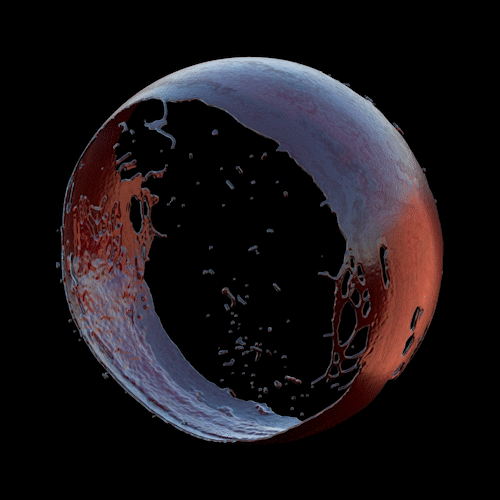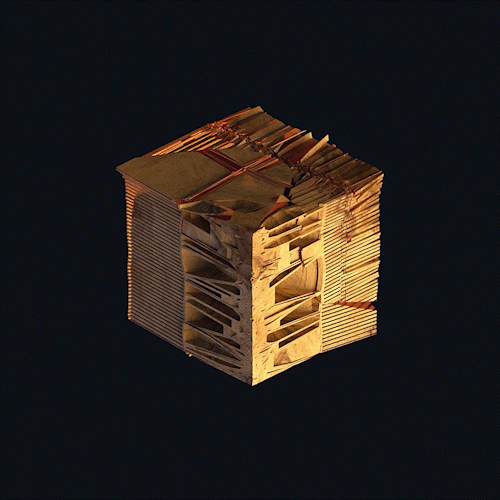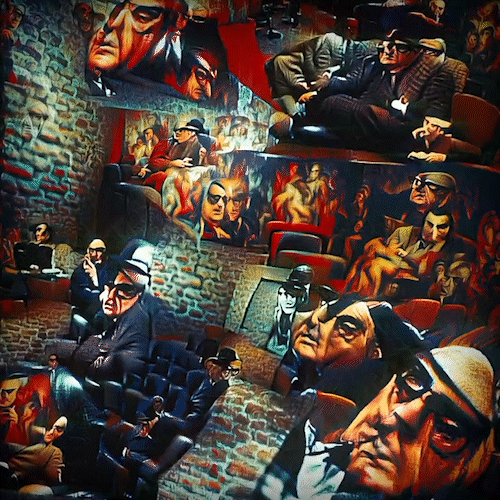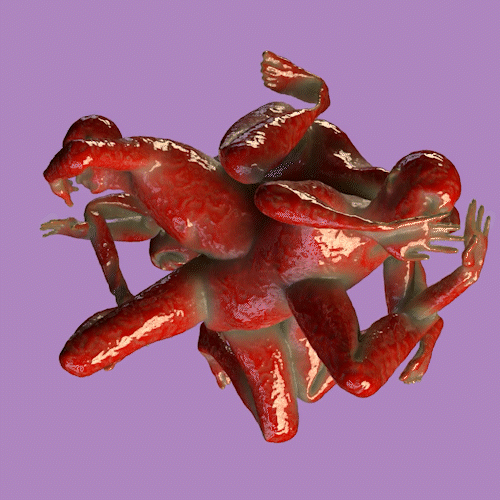THE MOTION ART JOURNAL: LASSINGER’S DREAM MACHINES

DREA•M•ACHINE | no.010 - "a sea of deep Dreams"
MARCH 10TH, 2022
Lassinger is Lars Nagler, a German freelance artist, filmmaker and electronic musician working in Leipzig and Pirna since 2007. He has been publicly funded to create short films and is free to explore his artwork full time. You can find his short film work here. But like most artists, he has jumped with both feet into the NFT revolution. And like many artists, he has tried various things like photography and 3D surrealist imagery. He has now found himself working with AI and the GAN toolset, as many other artists have begun to do. In this vein, he has produced some compelling new work called ‘the DREA•M•ACHINE series’ on Foundation that utilizes this technique.
GAN is fascinating because it reminds me of the Morphing craze of the early 90s, which I am old enough to remember first hand. For a few years, everyone was using morphing for everything from commercials to feature films, and then the technique became overused, and filmmakers stopped using it as much. It became just another tool in the animation digital effects toolset, used when needed.
The most famous example of this was Michael Jackson’s ‘Black and White’, in which it was exclusively used for the entire video. Filmmakers have always had a need to change one image to another to tell their story, and Morphing as a general technique has had a long history in film. You can read about it here. The GAN and AI techniques used today are more sophisticated versions of that technique, but visually the result feels similar. Images, either static or in motion, seamlessly change from one to another in a fluid, dreamlike way. In the current landscape, a famous example of this is Holly Herndon and Matt Dryhurst’s ‘Crossing the Interface’ series. The dreamlike quality of their work is shared with Lassinger’s DREA•M•ACHINE work.
But this technique can be used differently: Ivon Tau has created beautiful work using architectural photography that I have written about here. Helena Sarin has created work that feels like moving Abstract Expressionist paintings that I have written about here. For artists who use the technique, the challenge will be to integrate it into their work, so it is not simply a technique but a core part of their expression, and does not become a tired like Morphing in the 90s.
Lassinger’s DREA•M•ACHINEs create a swirling dreamlike motion loop that feels like there is a story, but you cannot fully follow it - it is suggested through the repeated moving images that keep changing while the camera keeps moving, and you can never really get a handle on what you are looking at. Just like a dream. But you keep watching because it keeps moving, and everything is tied together visually in an odd way. It is a unique new feel for motion imagery. In DREA•M•ACHINE 009, there are cliffs, water, and people in rooms that appear to be having a party. In DREA•M•ACHINE 010, it feels like science fiction with Astronauts, vague technology and a swirling psychedelic landscape…again all moving in a dreamlike way that is hard to stop watching.
Lassinger has been working on this technique over several still images that you can find in his various series on OpenSea and Teia. He has also done some unique slow experiments with motion you can find on his Teia page. It will be interesting to see how he develops this technique with motion, as he has done with the DREA•M•ACHINE series. As a longtime filmmaker, his NFT work tends to be long: The DREA•M•ACHINE work clocks in at over 2 minutes each. But the effect they have is that of Motion Art, of something you watch as one experience and not a narrative. That being said, Lassinger says below he is working on a longer film using this technique. Time will tell.

THE FRAGILE no. 03

THE CIRCLE #01

SLO-MO-WOOD no. 01

DREA•M•ACHINE | no.009 - "a french Contempt"

THE FRAGILE No. 01





Where did you grow up? Did you have art training?
I grew up in East Germany. When the wall came down, I had just finished school. Due to a lack of apprenticeships in my home region, I moved to West Germany, and I became a cook for a few years. After that, I worked as a stage decorator in a theater for a few years. During this time, I started to photograph extensively. From 1998 to 2007, I studied Visual Communication at the Bauhaus Weimar and during this time, I went through different fields of interest; photography, narrative short film, experimental short film. It wasn't until I got my diploma that I started to be active in the field of 3d visualization. Since then, I have created experimental 3d films, music videos, music and commissioned works.
You have done work in photography, 3D that is static and motion, and now GAN in both static and motion. What is the evolution of your work, and what got you into doing GAN work?
This is very easy to answer with just one word: Curiosity.
I am always interested in new trends and possibilities of artistic expression - if I understand the technical parts. I have no affinity for programming and coding - so if there wasn't a halfway understandable interface for AI art creation, I couldn't do it. That's why I'm very grateful that there are programmers who have created interfaces where you can understand and work with AI in a unique way. What interests me most about working with AI is the equal partnership. For me, AI is a great spirit that can do amazing things - if you write the correct script. I'm going to create a short film this year using these techniques.
What is your process for doing GAN work? Do you create the imagery in 3D and then run it through a GAN process? Or is it something else?
Very different. For my "SHAMANIC SESSIONS" series, I used 3D rendered templates for the first time, which were then run through GAN processes and edited afterwards.
For my "DREAMACHINE" series, I write very detailed scripts, which are then interpreted. The starting point is always a well-known theme from the history of the world and art.
Do you feel you will stay with doing GAN work?
Yes, I think so. The possibilities are fascinating, and indeed more doors will be opened and opportunities made possible.
How do you choose whether to make static or motion work?
It always depends on what and how you want to show. My "DREAMACHINES" always tell little stories that change settings and actions. The continuously evolving moving image is suitable for this.
Series like "SHAMANIC SESSIONS" or "THE PRAYERS" are more about portraits and a unique visual impression per image.
How long have you been in the NFT scene? How do you feel it has gone so far?
I've been in the NFT universe since March 2021. A lot has happened since then, both good and bad. In the middle of last year, I quit for a short time because bad scenes were becoming more frequent. For example, the very obvious art theft of a successful artist, who was reluctant to admit it and, even worse, was protected by some of his prominent collectors. So I lost a large amount of trust in this scene for the first time. Furthermore, I didn't particularly like that collectors wanted to explain to me how the system works. For example, there was a great liking for artificial scarcity at that time. That's not my thing at all. That's all changed a bit. In the meantime, I'm also visible enough to attract collectors who appreciate and buy my work. I hope for me that the curve continues to go up - it's become my life's center, and for an artist like me, who pursues his life and art in a bulky and stubborn way, the NFT universe is an ideal place - if you're recognized.
What artists do you like and follow?
Reuben Wu's work uniquely combines nature and technology to a perfectly balanced degree. As a friend of spectacular landscapes, I am doubly satisfied: by getting to know ever new corners of this earth and by their presence staged by Reuben. Here we come closer to the genius of each presented landscape.
For abstract painting, there is a fine line between interest and disinterest. Filippo's paintings are of great interest to me because they contain the "flowing" that I love. Layer upon layer can be discovered, and organic shapes meet technical dimensions.
I'm a big fan of alchemy - mixing elements, substances, and liquids. Ceren inspires me with her 3D animations; I like to call them "digital alchemy." Many different processes, meanings and interactions can be seen and are open to unlimited interpretation.
Do you think that Motion Art is a new Art form, as I laid out in my initial piece? Please be honest; some people say 'no,' which is fine. I am just interested in the discussion.
I always thought motion art had been around for a long time. That's why I don't see a birth of a new art form in it. But since the NFT universe exists, more and more genres and outgrowths evolve and flourish in it. That's very interesting and, of course, often disappointing. Just like it's disappointing anyway to see how much bad art becomes hype and is sold successfully. But that's always subjective and doesn't matter in the overall context. ;)


